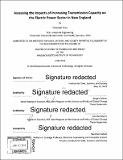Assessing the impacts of increasing transmission capacity on the electric power sector in New England
Author(s)
Tries, Christoph
DownloadFull printable version (8.691Mb)
Other Contributors
Technology and Policy Program.
Advisor
Sergey Paltsev and Jennifer Morris.
Terms of use
Metadata
Show full item recordAbstract
This thesis explores the evolution of the electric power sector in New England under the expansion of transmission capacity and under policy with increasing Clean Energy Standards (CES). I use EleMod, a Capacity Expansion Planning model, to compare (1) the reference case of current transmission assets, (2) increasing transmission interface capacities within New England, (3) increasing interconnection capacities with Canada, and (4) both capacity expansions. Transmission expansion allows electricity trade between states and enables them to take advantage of localized, intermittent resources like wind power. Increasing the interconnection capacity with Canada allows the system to optimally allocate the available hydropower energy for imports in the hours of highest net demand. Both transmission expansions together make even stronger use of their contributions. For the capacity expansion model, I choose a set of generation technologies available in New England, and supply cost and operational data from public domain sources. My contributions to EleMod include: (1) the representation of transmission interfaces for New England; (2) the addition of an CES policy standard forcing generation shares from a subset of CES-eligible resources; (3) the modeling of an external hydro reservoir resource in Canada that can be used to supply the load in New England based on cross-border interconnection constraints and the total available energy per year; and (4) the detailed state-level representation of the New England power sector with generation technologies, installed capacities, transmission interface capacities, and CES targets. Policy scenarios increase CES from an average of 25% in 2018 in the base scenario to 95% in 2050 in the decarbonization scenario. Through all policy scenarios, combined-cycle gas plants (GasCC) with carbon capture and storage (CCS) technology dominate the capacity expansions. Increases in transmission capacity lead to higher shares of wind in generation, especially when both transmission and interconnection are expanded. Natural gas, in the form of GasCC with and without CCS, takes shares of the generation mix of up to 85% by 2050. Thus, I also assess the role of pipeline capacities into New England. Because other natural gas uses like residential heating demand have priority over generators, gas-fired power plants cannot expect to meet all their demand during critical periods of shortage in the winter. However, this issue is part of a larger integrated resource planning process. Both transmission and interconnection expansion reduce total system costs by an annual 3.95% and 4.29%, respectively. Because transmission costs are not included in the model, I separately assess the costs and benefits of both transmission expansion scenarios. Transmission expansions from Maine to Massachusetts of 2,000 MW and interconnection expansions to Canada of 3,000 MW and 4,500 MW from Maine and Vermont, respectively, allow for optimal allocation of flows across lines in over 90% of the hours. For interconnection, the calculation estimates costs to be about 1% higher than the benefits, and for transmission within the region the benefits exceed the costs by about 40%.
Description
Thesis: S.M. in Technology and Policy, Massachusetts Institute of Technology, School of Engineering, Institute for Data, Systems, and Society, Technology and Policy Program, 2018. Cataloged from PDF version of thesis. Includes bibliographical references (pages 69-74).
Date issued
2018Department
Massachusetts Institute of Technology. Engineering Systems Division; Massachusetts Institute of Technology. Institute for Data, Systems, and Society; Technology and Policy ProgramPublisher
Massachusetts Institute of Technology
Keywords
Institute for Data, Systems, and Society., Technology and Policy Program.